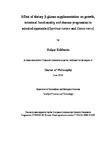Effect of dietary β-glucan supplementation on growth, intestinal functionality and disease progression in selected cyprinids (Cyprinus carpio and Danio rerio)
| dc.contributor.supervisor | Davies, Simon J Prof. Dr. | |
| dc.contributor.author | Kühlwein, Holger | |
| dc.contributor.other | Faculty of Science and Engineering | en_US |
| dc.date.accessioned | 2014-01-30T13:20:08Z | |
| dc.date.available | 2014-01-30T13:20:08Z | |
| dc.date.issued | 2014 | |
| dc.identifier | 10253016 | en_US |
| dc.identifier.uri | http://hdl.handle.net/10026.1/2873 | |
| dc.description.abstract |
Three experiments were conducted to investigate the effects of dietary supplementation of a ß-(1,3)(1,6)-D-glucan derived from the yeast Saccharomyces cerevisiae, on growth performance parameters and intestinal functionality in mirror carp (Cyprinus carpio L.) and on progression of a chronic, pre-existing mycobacteriosis in zebrafish (Danio rerio). The 1st experiment revealed that mirror carp fed diets containing 1% and 2% ß-glucan showed significant improvements in growth performance compared to fish fed both the control and the 0.1% ß-glucan containing diet. Equally, fish fed diets supplemented with 1% and 2% ß-glucan displayed significantly higher infiltration of leukocytes into the epithelial layer of in the anterior intestine. This effect was not observed in the posterior intestine. There were no significant differences in the intestinal absorptive surface area and number of goblet cells in either intestinal region. Compared to control fed fish, the haematocrit value was significantly elevated in fish fed the 2% ß-glucan diet. The blood monocyte fraction was significantly higher in fish fed the 1% and 2% ß-glucan diets. No significant changes were observed in the other blood parameters assessed. In the 2nd experiment, culture-dependent microbiology unveiled that aerobic heterotrophic bacterial levels in mirror carp intestinal microbiota were unaffected by dietary β-glucan after two and four weeks. No effects were observed on the allochthonous lactic acid bacteria (LAB) populations at either time point, however, reduced autochthonous LAB populations were observed at week four. PCR-DGGE confirmed these findings through a reduction of the abundance of autochthonous LAB operational taxonomical units (OTUs) in β-glucan fed fish compared to the control fed fish. DGGE analyses also revealed that dietary β-glucan reduced the number of OTUs and the species richness of the allochthonous microbiota after two weeks, but not after four weeks. In contrast, dietary β-glucan reduced the number of OTUs, the species richness and diversity of the autochthonous microbiota after two weeks, and those parameters remained reduced after four weeks. Intestinal microvilli length and density were significantly increased after four weeks in fish fed diets supplemented with 1% β-glucan. The 3rd experiment comprised of two individual trials where dead or moribund fish displayed the classical clinical signs of mycobacteriosis. In experiment I (200 days), zebrafish were fed diets supplemented with 0% (control, C) or 0.1% ß-glucan (B). In experiment II (63 days), zebrafish were fed diet C or diet B continuously or both diets intermittently (CB) in weekly intervals. Dietary ß-glucan failed to improve survival rates in both experiments. In experiment II, histopathological analysis revealed absent (normal appearance), moderate and severe manifestations of granulomas. Ecological microbial community analysis of intestinal samples collected at day 63 showed significantly higher number of OTUs, species richness and diversity in treatments B and CB compared to the control treatment. In conclusion, high dietary ß-glucan supplementation levels enhanced growth performance, leukocyte infiltration in the anterior intestine and the ultrastructure of the enterocytes in mirror carp without detrimental effects on intestinal morphology or the haemato-immunological parameters assessed. In addition, intestinal microbial communities were altered in healthy mirror carp and diseased zebrafish. It was also demonstrated that dietary ß-glucan failed to impact the progression of a pre-existing mycobacteriosis in zebrafish. Future research is required to investigate the underlying reasons for the observed effects by applying advanced molecular techniques, and whether these effects occur under commercial husbandry, or in different fish species. | en_US |
| dc.description.sponsorship | This work was supported by the European Community's Seventh Framework Programme (FP7/2007-2013) under Grant agreement number PITN-GA-2008-214505 | en_US |
| dc.language.iso | en | en_US |
| dc.publisher | University of Plymouth | en_US |
| dc.title | Effect of dietary β-glucan supplementation on growth, intestinal functionality and disease progression in selected cyprinids (Cyprinus carpio and Danio rerio) | en_US |
| dc.type | Thesis | |
| plymouth.version | Full version | en_US |
| dc.identifier.doi | http://dx.doi.org/10.24382/4089 |
Files in this item
This item appears in the following Collection(s)
-
01 Research Theses Main Collection
Research Theses Main


